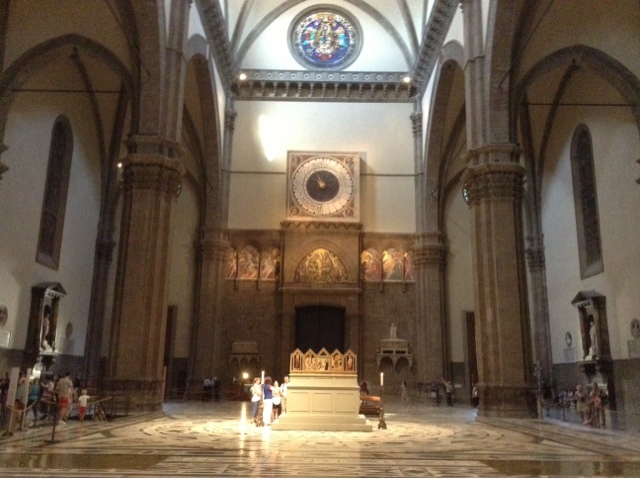We caught an early train from Pisa, and arrived in Florence at midday. After finding our hotel, we made our way along the cobbled Florentine streets and through umpteen alleys and lane ways, and soon crossed the river Arno to the southern side. We passed hordes of tourists, fiat puntos, smart cars, more than enough vespas, and alleys completely lined with parked motor bikes as if they had exclusive rights to park there. We spotted the Duomo, the monumental cathedral which dominates Florence's skyline, very soon on our walk, and, as we began climbing to the top of the Plazzale Michelangelo, it and the other great churches of Santa Maria Novella and Santa Croce appeared in view.
At the top of the Plazzale Michelangelo, the visitor can appreciate the physical position of the city. From here, as you look down onto Firenze, as it's known by its Italian name, you are facing north. The city below stretches up and down, west to east, along the Arno Valley, and it seems to extend for many miles. On both sides of the Valley, Florence is bordered by endless mountains of varying sizes and shades of green, with the odd blue hazy hue on distant peaks. This superb natural environment offers hiking and unlimited mountain exploring. Looking back upon the city, Florence itself promises just as much exploring to the tourist with time, its surprising frescoes, its hidden gardens, its myriad buildings, which, when packed closely together form a maze of man-made canyons. Seemingly running the entire length of Florence, and keeping roughly parallel with the mountains, is the river Arno, which we encountered first in Pisa. Six bridges span the Arno; the oldest is the Ponte Vecchio, a medieval arched bridge made of stone.
One chocolate-tiramisu gelato and another pistachio and American cherry gelato later, we descended and re-entered the streets of the city. Florence is another Italian city with a few palaces, and there are about 32 museums here. Florence is coffee, Florence is pizza, it is art, Michelangelo, and it is the sculpture of David. David seems to be everywhere. More about him tomorrow.
Florence is also about gold, and on the Ponte Vecchio, the visitor will find several gold jewellery stores actually built on the bridge, which, apparently, was once common. At any one moment, scores of passers by will stop to admire the gold. They may or may not stop to inspect the cheap sunglasses or the latest, weirdest thing you ever saw being flogged by some person in the street desperate to make a fast five euros, or "How much you pay!?". Nah, not interested.
From there, we slowly approached the Galleria Dell'Accademia, a museum which houses Michelangelo's sculpture of David, to enquire about entry tickets. We'll return tomorrow. We walked on, and passed the Duomo. Closed already. Not to worry. We'll come back tomorrow.
We decided to find dinner, and entered a diminutive restaurant called dal Barone. One solitary lady was serving. As usual, I started by coining as much of a proper Italian sentence as possible. Usually, when I do this, I get an immediate response in English. This would happen in Spain, and very often even in France. But not this time. For once, a local European customer service person in a major tourist centre spoke entirely to me in her own language. She uttered not one word of English. It became a challenge communicating, and I drew as much as I could on my small reserves of Italian vocabulary. I was pleased with the effort. Here, Jean and I shared a maxi cutting board for two with cold cuts, cheese, and vegetables in oil with warm bread. For dessert, I alone had cantucci (Tuscan aniseed flavoured almond biscuits) with port. I offered the lady a tip. She appeared baffled, and finally I remembered there is no tipping in Italy.
The Duomo dominates Florence's skyline, with mountains behind
The river Arno in the foreground
Gold jewellery shops on Ponte Vecchio



















































